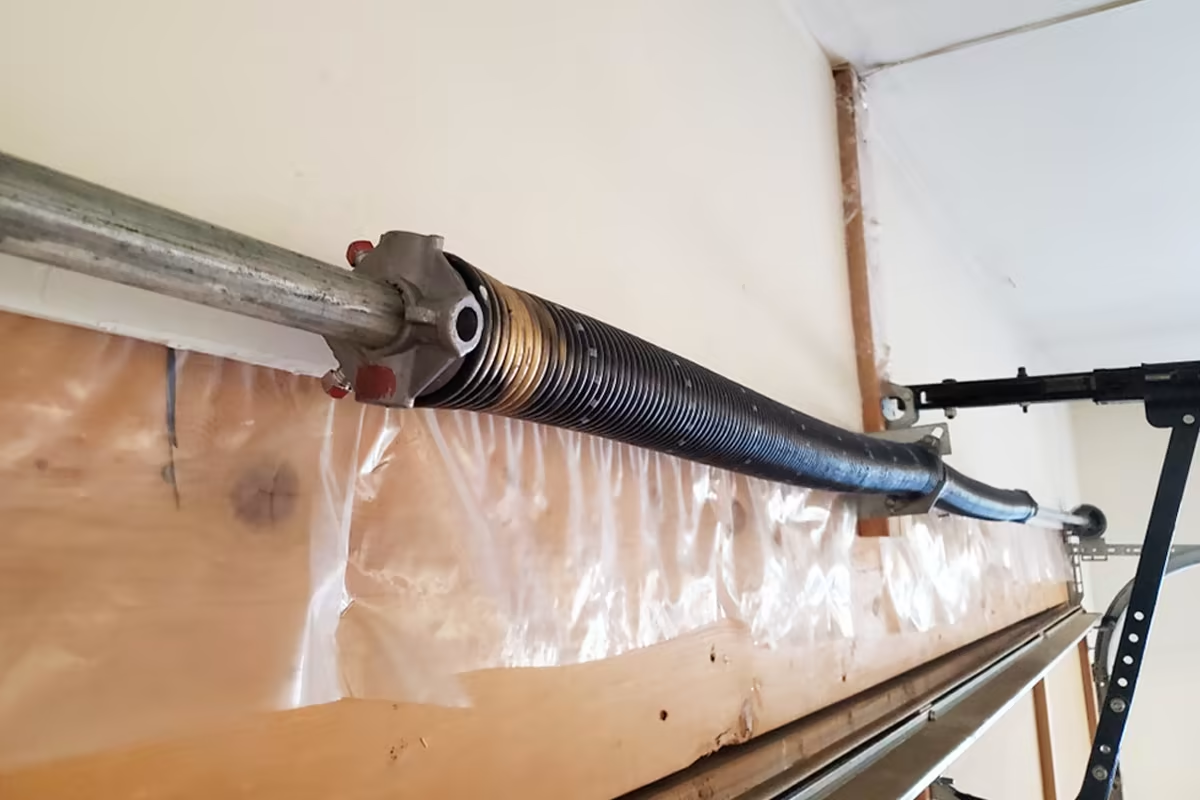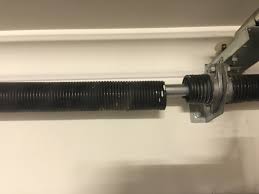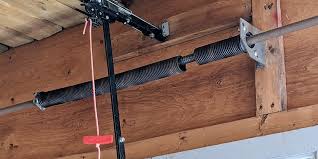Garage door springs need replacing? Our Katy, TX, expert team provides reliable, high-quality services to ensure your door works like new again.
When it comes to garage doors, one of the most common issues homeowners encounter is a broken or worn-out spring, and that’s where Garage Door Spring Replacement becomes essential. Over time, these springs take on the daily wear and tear of lifting a heavy garage door, making them prone to failure. But tackling this seemingly straightforward job yourself can be more complex—and dangerous—than it appears. The springs operate under high tension, so mishandling them could lead to severe injuries or damage.

In this guide, we’ll explain the basics of garage door springs, how to spot signs of wear, and the step-by-step replacement process. We’ll also discuss the difference between torsion and extension springs, the necessary tools, and the safety precautions you need to know. By understanding the details, you’ll be better prepared to decide whether to tackle the job yourself or call in a professional.
Safety is crucial when dealing with these high-tension parts, and knowing when to seek expert help can save time and prevent accidents. This blog covers everything from the cost of replacement to tips on extending the life of your new springs. Keep reading to learn what you need to know about safely maintaining and replacing garage door springs!
What Are Garage Door Springs?
Garage doors operate with two main types of springs: torsion springs and extension springs. These powerful devices ensure the smooth operation of your door by providing the necessary force to lift and lower it effortlessly.
Torsion Springs
Torsion springs are the most common type used in garage doors today. They are mounted above the garage door and tightly wound when the door is closed. As the door opens, these springs unwind, transferring their energy to the garage door’s cables and pulleys, thus lifting the door. Torsion springs are durable and can handle significant weight, but when they fail, the force they exert can cause considerable damage.
Extension Springs
Extension springs are generally found on older garage doors. They are located on each side of the door and stretch as the door closes, storing energy that assists with the door’s opening. While not as durable or powerful as torsion springs, extension springs are more affordable but also carry significant safety risks, particularly if they lack safety cables.
Signs Your Garage Door Spring Needs Replacement

Garage door springs don’t last forever. The average lifespan of a garage door spring is about 10,000 cycles, which translates to roughly seven years for an average home. Here are some tell-tale signs that it’s time to replace your garage door spring:
- The Door Feels Heavy or Won’t Stay Open: If you’re struggling to lift the door or it starts to fall after opening, this likely indicates that the spring is no longer providing enough force.
- Visible Gaps in the Spring: Look closely at the springs. If you see a gap, this could indicate a break, which means the spring is no longer effective.
- The Door is Crooked: If one side of the door is higher than the other when it’s in motion, you might have a broken spring on one side.
- Loud Noise: Hearing a loud bang from the garage? That’s usually the sound of a spring snapping.
- Slow Opening or Closing: A garage door that operates slower than usual may indicate worn-out springs.
Safety Considerations for Garage Door Spring Replacement
Replacing garage door springs is not DIY-friendly due to the extreme tension these springs are under. If not handled properly, these springs can cause serious injuries. Here’s why:
- High Tension: Garage door springs store a tremendous amount of energy. If they suddenly snap or unwind incorrectly, they can cause severe injuries or even be fatal.
- Tools and Skills Needed: Spring replacement requires specific tools and techniques. Attempting the replacement without proper knowledge can damage the door, injure someone, or cause worse.
Given these risks, it’s usually best to call in a professional. Garage door technicians are trained to handle these high-tension parts safely and have the equipment needed to complete the job without incident.
Step-by-Step Guide to Replacing a Garage Door Spring
If you’re experienced with home repairs and willing to take on the task, here’s a general overview of replacing a garage door spring. However, remember that this is a high-risk task and should only be performed if you are confident in your abilities.
1. Gather Your Tools
You’ll need:
- Safety goggles and gloves
- Winding bars (for torsion springs)
- A set of sockets and wrenches
- A sturdy ladder
- A friend or helper
2. Disconnect the Garage Door Opener
Unplug the opener to prevent the door from accidentally opening while you’re working. Pull the emergency release cord to disconnect the door from the opener.
3. Secure the Door
Clamp the garage door to prevent it from moving while you’re working. This is critical for safety.
4. Loosen the Unbroken Spring (for Torsion Springs)
Using winding bars, unwind the intact spring slowly and carefully. You must always maintain control over the bar to avoid sudden release.
5. Remove the Old Springs
Use your wrench to remove the bolts holding the springs in place. Once the bolts are out, you can slide the broken spring off the torsion bar or remove the extension spring.
6. Install the New Spring
Slide the new torsion spring onto the bar or attach the new extension spring to the brackets. Secure everything with the appropriate bolts.
7. Wind the New Torsion Spring
This is the most dangerous part. Using the winding bars, carefully wind the torsion spring according to the manufacturer’s specifications. For extension springs, reattach the cables and make sure the spring is securely attached.
8. Test the Door
Reconnect the garage door opener and test the door’s functionality. You’re done if it operates smoothly and without jerking or odd sounds!
When to Call a Professional
While the steps above outline the general process, it’s critical to note that spring replacement is a hazardous job. Here’s when you should call a professional:
- If You Lack the Necessary Tools: Winding bars are essential for handling torsion springs safely.
- If You’re Unsure About the Type of Spring: Garage door springs vary, and using the wrong replacement part can damage the door and create additional safety risks.
- If You Experience Problems After Installation: A professional technician will have the skills to make the necessary adjustments if the door isn’t balanced or operates unevenly.
The Cost of Garage Door Spring Replacement

On average, professional garage door spring replacement costs between $150 and $350 per door, depending on the type and size of the spring. Due to their durability and complexity, torsion springs are generally more expensive than extension springs. While this may seem costly, ensuring the job is done safely and effectively is worth the price.
How to Extend the Life of Your Garage Door Springs
After replacing your springs, you’ll want to extend their lifespan as much as possible. Here are some maintenance tips:
- Lubricate Regularly: Apply a lubricant designed for garage door parts to keep the springs moving smoothly.
- Balance the Door: Check that your garage door is properly balanced by disconnecting the opener and lifting the door halfway. If it stays put, it’s balanced.
- Limit Use: The more you use your garage door, the faster the springs wear out. Consider using alternative entrances when possible.
- Schedule Routine Inspections: Have a professional inspect your garage door annually to catch any issues before they become costly repairs.
DIY vs. Professional Garage Door Spring Replacement
If you’re weighing the pros and cons of tackling the project yourself versus hiring a professional, consider the following:
DIY Replacement
- Cost Savings: Doing it yourself could save you $100-$200 in labor costs.
- Availability of Tools: Do you already have the necessary tools? Winding bars and proper safety gear are essential.
- Skill Level: Have you tackled similar tasks before? This job requires comfort with high-tension components.
Hiring a Professional
- Safety First: Professionals have the skills and equipment to handle high-tension springs safely.
- Warranty and Quality: Many garage door repair companies offer warranties on parts and labor, which provides peace of mind.
- Time and Effort: For most, the time spent learning and executing the job safely may not be worth it. A professional can often complete the job in under an hour.
Garage Door Maintenance Tips
Regular maintenance can help prevent future spring issues. Here are a few tips:
- Inspect Cables and Pulleys: The entire system relies on multiple moving parts that should be free of damage or wear.
- Listen for Noises: Unusual sounds, like grinding or squeaking, can signal an issue. Catching these early can help prevent more significant problems.
- Tighten Hardware: Garage doors move frequently, causing screws and bolts to loosen over time. Tightening these regularly ensures smooth operation.
Frequently Asked Questions (FAQs) on Garage Door Spring Replacement
Can a garage door work without springs?
No, garage doors require springs to operate. The springs counterbalance the door’s weight, making it manageable to lift. Without springs, the door would be extremely heavy and difficult to open, putting stress on the opener and potentially leading to damage or injury.
Does a 2-car garage need 2 springs?
Yes, 2-car garage doors generally need two springs for balanced weight distribution. This setup ensures smoother operation and reduces strain on the door opener. It also prolongs the lifespan of both the springs and the opener by evenly sharing the load, which is vital for double-wide garage doors.
Can you repair a garage door spring?
Due to the nature of the metal and tension involved, garage door springs are not typically repaired. Instead, broken or worn springs are replaced. Attempting repairs is generally unsafe and may not restore the spring’s functionality. For reliable operation, a new spring installation is the recommended approach.
Can I use my garage door with only one spring?
Using a garage door with only one spring is possible but not advisable. Most doors designed for two springs will experience uneven tension, which can strain the opener and the remaining spring. Operating this way can lead to quicker wear and further damage, so replacing both springs for balanced performance is best.
Are all garage springs the same size?
No, garage door springs come in various sizes and types, depending on the door’s weight, height, and material. Using the correct size is crucial for safe, smooth operation. Consulting with a professional ensures the correct spring choice for your specific door type, as different doors require different spring specifications.
Conclusion
Garage door spring replacement is an essential maintenance task that can improve the safety and longevity of your garage door. While DIYers might be tempted to tackle this job themselves, the risks often outweigh the rewards. A broken garage door spring can become a major inconvenience – or even a serious danger – if not handled properly. Investing in professional replacement ensures that your garage door operates safely and efficiently, providing you peace of mind for years to come.
Remember, your garage door is one of your home’s largest and most frequently used moving parts. Treat it with the care and attention it deserves, and it will serve you well in return. Whether replacing the springs or maintaining the door, a well-maintained garage door is key to a safe and convenient home.
End Note
At Lopez Garage Door, we understand how frustrating it can be when a garage door spring fails. A broken spring can leave your garage door stuck, but our experienced team is ready to get it back in working order quickly and safely. We specialize in garage door spring replacement, ensuring your door operates smoothly and reliably. Our services are thorough, efficient, and tailored to meet each client’s unique needs.
Beyond spring replacements, we offer a complete range of garage door services. From garage door maintenance to new door installations, we’re your go-to team in Katy, TX. Whether you’re in need of chain-drive or belt-drive openers, we have the expertise and options to suit every budget. Check out our gallery for examples of our work, visit our blog for tips and updates, or reach out through our Contact Us page to schedule your spring replacement today.

